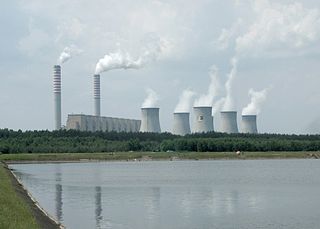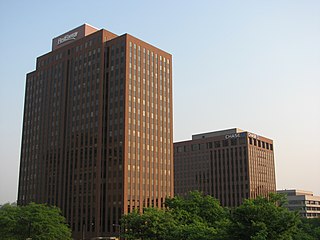
A fossil fuel is a fuel formed by natural processes, such as anaerobic decomposition of buried dead organisms, containing organic molecules originating in ancient photosynthesis that release energy in combustion. Such organisms and their resulting fossil fuels typically have an age of millions of years, and sometimes more than 650 million years. Fossil fuels contain high percentages of carbon and include petroleum, coal, and natural gas. Peat is also sometimes considered a fossil fuel. Commonly used derivatives of fossil fuels include kerosene and propane. Fossil fuels range from volatile materials with low carbon-to-hydrogen ratios, to liquids, to nonvolatile materials composed of almost pure carbon, like anthracite coal. Methane can be found in hydrocarbon fields alone, associated with oil, or in the form of methane clathrates.
India is the world's third largest producer and third largest consumer of electricity. The national electric grid in India has an installed capacity of 371.054 GW as of 30 June 2020. Renewable power plants, which also include large hydroelectric plants, constitute 35.94% of India's total installed capacity. During the 2018-19 fiscal year, the gross electricity generated by utilities in India was 1,372 TWh and the total electricity generation in the country was 1,547 TWh. The gross electricity consumption in 2018-19 was 1,181 kWh per capita. In 2015-16, electric energy consumption in agriculture was recorded as being the highest (17.89%) worldwide. The per capita electricity consumption is low compared to most other countries despite India having a low electricity tariff.

A fossil fuel power station is a thermal power station which burns a fossil fuel, such as coal or natural gas, to produce electricity. Fossil fuel power stations have machinery to convert the heat energy of combustion into mechanical energy, which then operates an electrical generator. The prime mover may be a steam turbine, a gas turbine or, in small plants, a reciprocating gas engine. All plants use the energy extracted from expanding gas, either steam or combustion gases. Although different energy conversion methods exist, all thermal power station conversion methods have efficiency limited by the Carnot efficiency and therefore produce waste heat.

American Electric Power (AEP) is a major investor-owned electric utility in the United States of America, delivering electricity to more than five million customers in 11 states.

TECO Energy Inc. is an energy-related holding company based in Tampa, Florida, and a subsidiary of Emera Incorporated. TECO Energy has several subsidiaries: Tampa Electric Company, which provides electricity to the Tampa Bay Area and parts of Central Florida; Peoples Gas Company, which provides natural gas throughout Florida; and TECO Services, which provides IT, HR, legal, facilities, and other services to current and former TECO subsidiaries.

FirstEnergy Corp is an electric utility headquartered in Akron, Ohio. Its subsidiaries and affiliates are involved in the distribution, transmission, and generation of electricity, as well as energy management and other energy-related services. Its ten electric utility operating companies comprise one of the United States' largest investor-owned utilities, based on serving 6 million customers within a 65,000-square-mile (170,000 km2) area of Ohio, Pennsylvania, West Virginia, Virginia, Maryland, New Jersey and New York. Its generation subsidiaries control more than 16,000 megawatts of capacity, and its distribution lines span over 194,000 miles. In 2018, FirstEnergy ranked 219 on the Fortune 500 list of the largest public corporations in the United States by revenue.

Homer City Generating Station is a 2-GW coal-burning power station near Homer City, in Indiana County, Pennsylvania, USA. It is majority-owned by General Electric and operated by NRG Energy. Units 1 and 2, rated at 660 MWe, began operation in 1969. Unit 3, rated at 692 MWe nameplate capacity, was launched in 1977. It employs about 260 people, and generates enough electricity to supply two million households.
The Dakota Coal Company, subsidiary of Basin Electric Power Cooperative, is based in Bismarck, North Dakota. It controls the rights to lignite reserves in North Dakota and provides financing for the Freedom Mine north of Beulah, ND. Dakota Coal Company is also responsible for marketing Freedom Mine lignite production. Dakota Coal and The Coteau Properties Co. work closely with their customers to ensure lignite quality doesn't hamper daily plant operations.

WEC Energy Group Inc., based in Milwaukee, Wisconsin, provides electricity and natural gas to 4.4 million customers across four states. The company operates through its brands – We Energies, Wisconsin Public Service, Peoples Gas, North Shore Gas, Michigan Gas Utilities, Minnesota Energy Resources and Upper Michigan Energy Resources.

Eraring Power Station is a coal fired electricity power station with four 720 MW Toshiba steam driven turbo-alternators for a combined capacity of 2,880 MW. The station is located near the township of Dora Creek, on the western shore of Lake Macquarie, New South Wales, Australia and is owned and operated by Origin Energy. It is Australia's largest power station. The plant has two smokestacks rising 200 m in height.

The William H. Zimmer Power Station, located near Moscow, Ohio, is a 1.35-gigawatt coal power plant. Planned by Cincinnati Gas and Electric (CG&E), with Columbus & Southern Ohio Electric and Dayton Power & Light (DP&L) as its partners; it was originally intended to be a nuclear power plant. Although once estimated to be 97% complete, poor construction and quality assurance (QA) led to the plant being converted to coal-fired generation. The plant began operations in 1991. Today, the plant is owned and operated by Vistra Energy.

Rockport Generating Station is a coal-fired power plant, located along the Ohio River in Ohio Township, Spencer County, Indiana, in the United States, near Rockport. The power plant is located along U.S. Route 231, approximately one mile north of the William H. Natcher Bridge, spanning the Ohio River. It is operated by Indiana Michigan Power, a subsidiary of American Electric Power.

Cumberland Fossil Plant is a pulverized coal-fired power station located west of Cumberland City, Tennessee, USA, on the south bank of Lake Barkley on the Cumberland River. Owned and operated by Tennessee Valley Authority (TVA), it has a gross capacity of 2,470 MW, and is the most powerful power station in Tennessee.

Clifty Creek Power Plant is a 1.3 gigawatt, 1,300 (MW) coal-fired power station located in Madison, Indiana. Clifty Creek is operated by the Indiana Kentucky Electric Corporation. It is named after Clifty Creek, the naming feature for the power plant, which enters the Ohio River nearby.

A coal-fired power station or coal power plant is a thermal power station which burns coal to generate electricity. Coal-fired power stations generate over a third of the world's electricity but cause hundreds of thousands of early deaths each year, mainly from air pollution.
The Portsmouth Gaseous Diffusion Plant is a facility located in Scioto Township, Pike County, Ohio, just south of Piketon, Ohio that previously produced enriched uranium, including weapons-grade uranium, for the United States Atomic Energy program and U.S. nuclear weapons program. The plant is in shutdown status and is in preparation for decontamination and decommissioning (D&D), with some facilities overseen by the United States Enrichment Corporation, a subsidiary of USEC Incorporated, a publicly traded corporation. The D&D work on the older facilities to prepare the site for future use is expected to continue through 2024 and is being conducted by Fluor-B&W Portsmouth LLC.

Edgewater Generating Station is a 380 megawatt (MW) coal power plant located in Sheboygan, Wisconsin. It provides electricity for customers in the northeastern part of Alliant Energy's Wisconsin Power & Light service area and service to several local municipal utilities. In 2009, it was the seventh largest generating station in Wisconsin, with a net summer capacity of 767 MW.
The Ohio Valley Electric Corporation (OVEC) is a company jointly owned by several parent electrical utilities. It is headquartered in Piketon, Ohio. OVEC and its wholly owned subsidiary, Indiana-Kentucky Electrical Corporation (IKEC), own and operate two coal-fired electrical generating plants. They are the Kyger Creek Power Plant, located near Gallipolis, Ohio, and the Clifty Creek Power Plant near Madison, Indiana.
The United States Enrichment Corporation, a subsidiary of Centrus Energy Corp., is a corporation that contracts with the United States Department of Energy to produce enriched uranium for use in nuclear power plants.

J.M. Stuart Station was a 2.3-gigawatt coal power plant located east of Aberdeen, Ohio in Adams County, Ohio. The power plant had four units and was operated by AES Ohio Generation, a subsidiary of the AES Corporation. It began operations in 1970 and ceased on May 24, 2018.
















